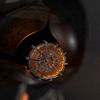The Dragon King, an innovative open world RPG
I have updated the Kickstarter page to include a simple tech demo of our rendering method. Please take a look and let me know what you think. Its a video only clip but I will update it in the morning to include a brief explanation and some additional features.
I have updated the Kickstarter page to include a simple tech demo of our rendering method. Please take a look and let me know what you think. Its a video only clip but I will update it in the morning to include a brief explanation and some additional features.
I think that some explanation is required - what exactly am I looking at here? It looks like spheres moving in a pattern, rendered in the normal way. Maybe the movement of these spheres is somehow related to quantum mechanics, but I do not see how this relates to a new rendering method.
Hey Captain Andrew,
Was this done in a game engine? I'm not sure what rendering method it's meant to demonstrate. The particle behavior seem to mimic that of nParticles, or any other particle simulation made using feild modifiers to control particle behavior. It looks like a particle emitter that's emitting a random seed controlled by a field, and/or soft body collisions. Is there any technical information you can provide? Was this done inside of a 3D application outside of a game engine or done inside a game engine.
I'd love to talk about some of the technology you use.
It seems like the object itself is an emitter. If it is, do you plan on editing the lifespan on the particles that are emitted from the object, or, even if they are being emitted from a locator what will their lifespan be? I'm also very interested in what use you have for what you have demoed.
Was this done in a game engine? I'm not sure what rendering method it's meant to demonstrate. The particle behavior seem to mimic that of nParticles, or any other particle simulation made using feild modifiers to control particle behavior. It looks like a particle emitter that's emitting a random seed controlled by a field, and/or soft body collisions. Is there any technical information you can provide? Was this done inside of a 3D application outside of a game engine or done inside a game engine.
I'd love to talk about some of the technology you use.
It seems like the object itself is an emitter. If it is, do you plan on editing the lifespan on the particles that are emitted from the object, or, even if they are being emitted from a locator what will their lifespan be? I'm also very interested in what use you have for what you have demoed.
Aloha Aerin. I have updated the Kickstarter video to include 3 simple demonstrations of the granule modeling and rendering system. The demo was created using the SPARK physics engine and Blender. SPARK is written in C++ using only the STL and Blender uses Python. This method provides the foundation for our game engine so technically its done in a 3D application. The algorithms used to control the granule emitter and the granules themselves are the major difference between a particle physics system and our granule physics system. The demo itself has very limited uses, but due to the extreme scalability of the method we are able to create entire planets rather easily. There are still quite a few finishing touches to be made, but we are steadily progressing. The end result will be environments that practically build themselves and can be destroyed down to a granular level. Let me know what you think.
That's actually very impressive Andrew. It reminds me of another technology company that I can't remember the name of. They have one very popular video online that demonstrates how their engine works, but basically environments, and objects are made up of tiny virtual atoms processed by a point cloud server if I remember correctly. Objects wouldn't need textures because each individual point that makes up an object (something in the hundreds of billions) has a specific color value.
It seems like it could be a realistic future for gaming, and virtual technology. Science, medicine, manufacturers, etc. If the kind of direction your taking this in is similar to that of being able to build worlds at a granular, or atomic level then you have my full attention. I'm eagerly awaiting more information.
You should start a developers blog that discusses daily, weekly, or biweekly any new developments you've made in the technology you're using. That would be an interesting read.
I'll be honest, I'm not entirely sure how to properly word my response.
It seems like it could be a realistic future for gaming, and virtual technology. Science, medicine, manufacturers, etc. If the kind of direction your taking this in is similar to that of being able to build worlds at a granular, or atomic level then you have my full attention. I'm eagerly awaiting more information.
You should start a developers blog that discusses daily, weekly, or biweekly any new developments you've made in the technology you're using. That would be an interesting read.
I'll be honest, I'm not entirely sure how to properly word my response.
I appreciate the vote of confidence and I agree that I should get a developers blog going. As stated before it is quite a juggling act to keep the development of this project going and getting our website up and running is next on the priority list. The company you are referring to is called Euclideon and their infinite detail technology is really quite amazing. It is not quite the same as our granular modeling but it is really close, the key difference being our string theory algorithm. NeoGenesis supports the Open Source and Free Software Initiatives and we intend to make our innovations available to everyone free of charge. The applications of this type of system are really quite extensive and we intend to produce designs for many of them. Our next update shouldn't be too far away and I hope to see you all there.
I have updated the tech demo to include a short fight scene utilizing our granule modeling and rendering method. Please let me know what you think.
Three questions.
1) What happened to this game you were developing 3 years ago? http://andrewbrewer.webs.com/
2) Why do you use military ranks?
3) What did you write that made you an established writer?
It is in my nature to examine a person's character if they are asking me to invest money in them. I tend to use the net to do so, as I would expect of most Kickstarter contributors in the absence of a well presented campaign.
1) What happened to this game you were developing 3 years ago? http://andrewbrewer.webs.com/
2) Why do you use military ranks?
3) What did you write that made you an established writer?
It is in my nature to examine a person's character if they are asking me to invest money in them. I tend to use the net to do so, as I would expect of most Kickstarter contributors in the absence of a well presented campaign.
Just out of curiosity, why are there only a couple seconds of "fight" at the end of a long and rather boring sphere demo? You're trying to make an RPG, right? I'd think that it would be far more relevant to scrap the sphere demo and do a full demo showing a more fleshed out fight instead.
This topic is closed to new replies.
Advertisement
Popular Topics
Advertisement








